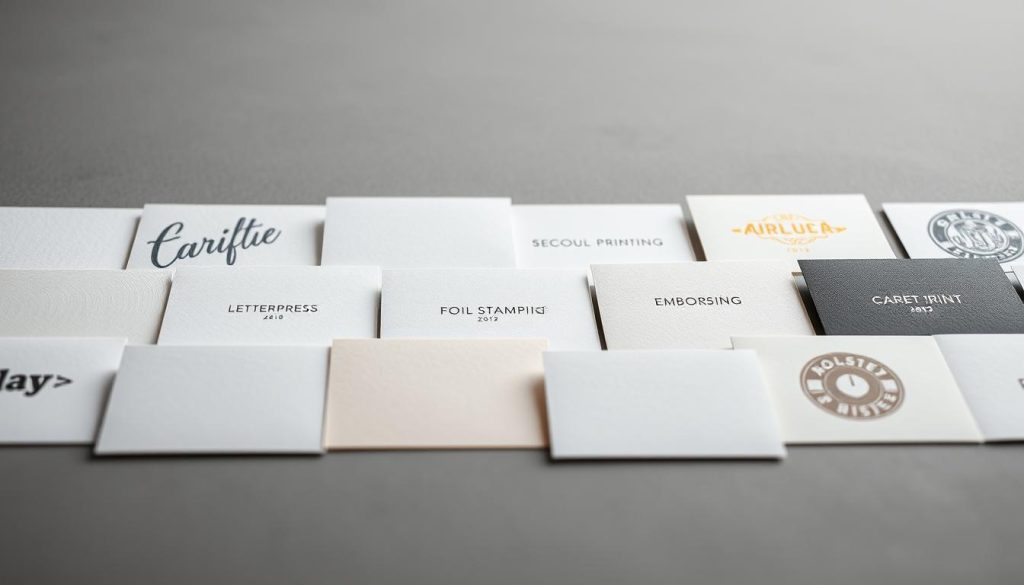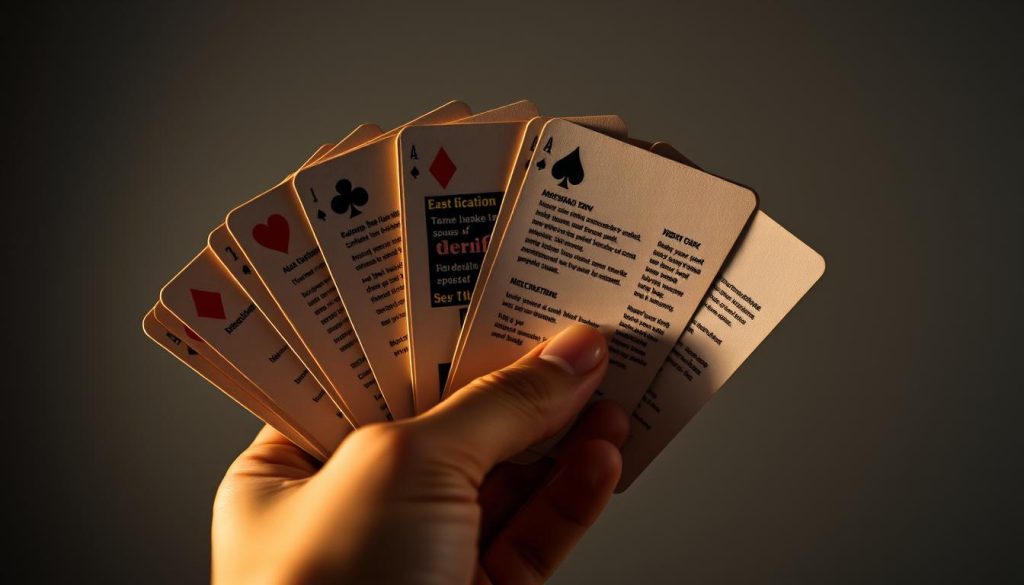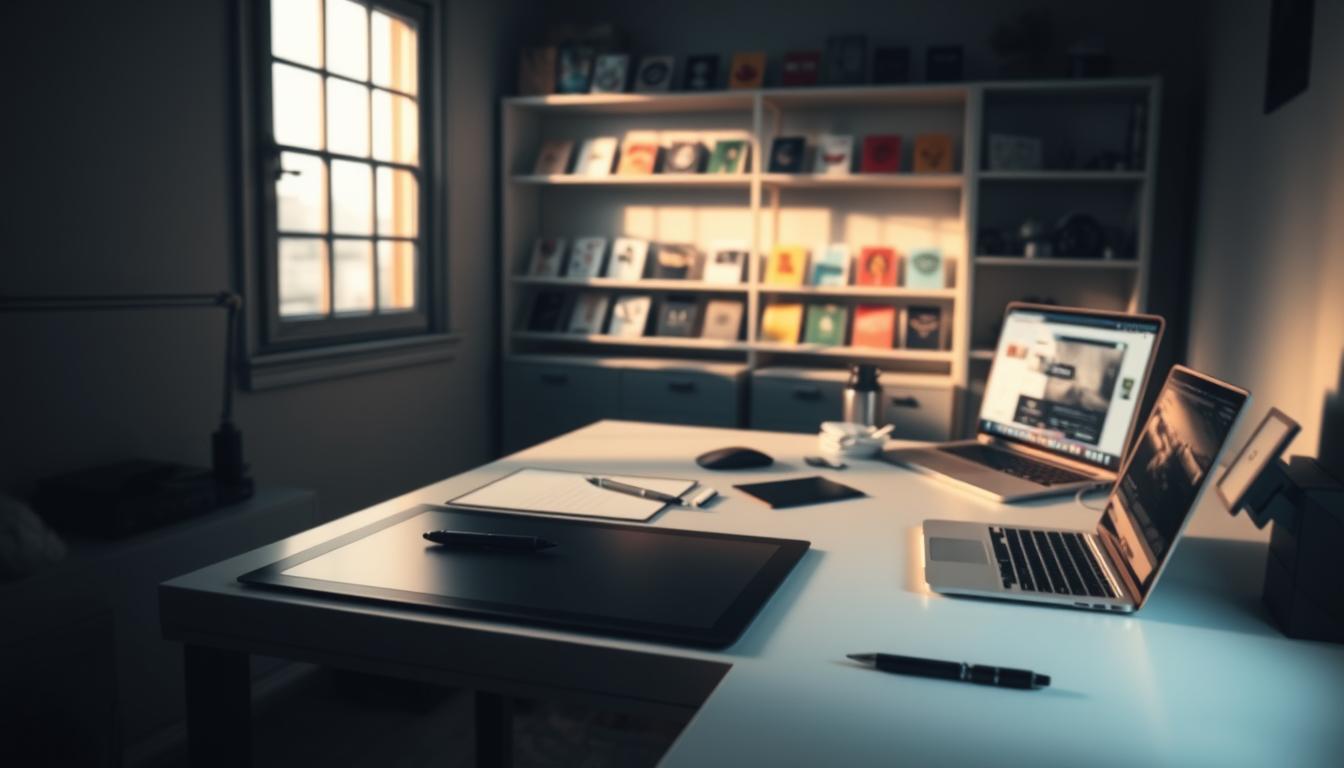Designing personalized cards is fun and creative. It lets you make special cards that show off your style and personality. This makes ordinary greetings into something truly special.
Creating business cards, greeting cards, or invitations is all about creativity. The right approach lets anyone make stunning cards. These cards will leave a lasting impression.
This guide will show you how to design custom cards step by step. You’ll learn about design principles and choosing the right materials. You’ll see how to make cards that show your vision and message.
Don’t worry if you have no design experience. Our guide will help you learn and grow. You’ll become confident in bringing your card ideas to life. Get ready to create cards that are truly unique.
Understanding the Basics of Card Design Elements
Making great cards needs a deep grasp of design basics. Card design elements are more than looks—they’re tools that send messages through visuals.
Good card design mixes key parts for a strong visual effect. Designers must think about many things to make cards pop and share their message well.
Color Theory and Psychology in Card Design
Color is key in card design, shaping feelings and grabbing attention. Each color brings its own emotions and meanings:
- Red: Passion, energy, excitement
- Blue: Calm, professionalism, trust
- Green: Growth, harmony, nature
- Yellow: Optimism, happiness, creativity
Typography Selection and Hierarchy
Typography is vital in card design, showing personality and making text clear. Choosing the right fonts means knowing:
- Font personality and brand fit
- How easy it is to read
- Size and weight changes
- Spacing and kerning
Balance and Composition Principles
Good composition turns good design into great. Designers need to balance visuals well. This makes layouts that lead the viewer’s eye and share info smoothly.
Getting good at these design elements takes practice, creativity, and knowing how to communicate visually. By using color, choosing fonts wisely, and balancing layouts, designers can make cards that stick in people’s minds.
Essential Tools and Software for Custom Card Creation

Creating stunning custom cards starts with the right tools. Both pros and hobbyists have many digital options. They help bring creative ideas to life.
Top graphic design tools have great features for card making:
- Adobe Illustrator – Professional vector design platform
- Canva – User-friendly design tool with templates
- Photoshop – Advanced image editing capabilities
- Procreate – Digital illustration software for iPad
Digital card design software is flexible for all designers. Beginners can use Canva’s easy drag-and-drop interface. Advanced users might like Adobe Creative Suite for detailed work.
When picking card design software, think about these things:
- Ease of use
- Available design features
- Cost of subscription
- Compatibility with your devices
Free and paid graphic design tools have their own benefits. Online platforms are quick, while professional software is detailed. Your choice depends on your design needs and budget.
How to Design Custom Cards: Step-by-Step Process
Making a custom card is a mix of creativity and skill. It’s a journey from idea to finished product. Designers go through many steps to make cards that look great and mean something.
Starting a card project means finding lots of design ideas. Designers look at many things to get their ideas:
- Online design platforms like Behance and Pinterest
- Nature and architectural photography
- Art galleries and museum exhibitions
- Personal experiences and cultural influences
Creating Initial Sketches and Concepts
Sketching out ideas is a key part of making a card. Designers try different things to find the best idea. These rough drafts help see where ideas can go.
- Start with loose, quick pencil sketches
- Experiment with different layout compositions
- Explore color palette variations
- Consider typography and graphic elements
Refining Your Design Elements
After sketching, designers make their ideas better. They look at each part and make changes to make it better. This part takes time and trying new things.
Improving a design means checking colors, using space well, and making sure it’s easy to see. By carefully checking and changing things, designers can make their cards stand out.
Choosing the Right Paper and Materials
Choosing the right paper and materials is key for stunning custom cards. The right card stock can make your design stand out. It turns a simple piece of paper into something memorable.
Designers have many paper types to choose from. Each material has its own look and feel. Here are important things to think about when picking your card stock:
- Thickness and weight of the paper
- Surface texture and finish
- Color and opacity
- Durability and longevity
Designers say to think about the card’s purpose when picking materials. Business cards need strong card stock for handling. Greeting cards might want a softer, elegant feel. Some popular papers include:
- Glossy coated stock
- Matte uncoated paper
- Recycled environmental papers
- Textured specialty card stock
Those watching their budget can find quality materials that are affordable. Trying out different card stocks can help you find the perfect one for your design.
Incorporating Personal Branding Elements
Custom cards are great for showing off your personal or business style. They turn simple messages into powerful visual statements. These cards show off your unique style and professional vibe.
When making custom cards, picking the right logo is key. Your logo is like a visual flag that shows who you are. It helps people recognize you everywhere they see it.
Logo Placement and Size Considerations
Choosing where to put your logo is important. It should be seen but not too big. Here are some tips:
- Put your logo where it’s easy to see but doesn’t take over
- Leave enough space around the logo for it to breathe
- Make sure the logo fits well with the card’s size
- Use high-quality logos for clear printing
Brand Color Integration
Using the right colors is key to making a strong impression. Your colors should match your brand’s personality. They should also make people feel something when they see them.
- Use your main colors wisely
- Keep colors consistent throughout the design
- Choose colors that make your design easy to read
Visual Identity Consistency
Keeping your design consistent makes your cards stand out. A unified look shows you’re serious about your image. It leaves a lasting impression on people.
- Make sure your card fits with your brand’s style
- Use the same fonts and graphics everywhere
- Show your brand’s values through your design
Custom Card Printing Methods and Techniques

Choosing the right card printing method is key to a great final product. Designers and businesses have many options for making custom cards look amazing.
Digital printing is a top pick for many. It has several benefits:
- Quick turnaround times
- Cost-effective for smaller print runs
- High-quality color reproduction
- Flexibility for personalized designs
Offset printing is another important technique. It’s great for big volumes and consistent colors. It’s often chosen for:
- Business cards needing exact color matches
- Large marketing materials
- Projects needing top print clarity
When deciding between digital and offset printing, think about your project. Consider the quantity, budget, and design complexity. Professional print shops can help pick the best method for you.
Getting your digital files ready is also key. Make sure your images are high-resolution, colors are correct, and bleed margins are right. This ensures the best results.
Adding Special Effects and Finishes
Card design is more than just printing. Professional designers use special finishes to make cards stand out. These techniques turn simple cards into powerful marketing tools that grab attention and show off brand quality.
Choosing the right finishes can make your design look and feel amazing. Each method brings its own look and feel that makes your card look more professional.
Embossing and Debossing Options
Embossing makes design elements pop by raising them. This adds texture and depth to cards. It lets designers:
- Create three-dimensional visual effects
- Highlight specific design elements
- Provide a luxurious tactile experience
Foil Stamping Techniques
Foil stamping adds shiny or metallic touches to designs. Designers can pick from many foil colors and finishes to match their brand.
- Gold and silver metallic foils
- Holographic foil options
- Matte and glossy finishes
Spot UV and Lamination Choices
Spot UV coating adds shine and protection to certain areas. Lamination makes cards last longer and look polished.
- Selective glossy highlights
- Enhanced color protection
- Increased card longevity
Trying out these finishes can make your design truly special. It leaves a lasting impression on those who receive it.
Common Design Mistakes to Avoid

Creating custom cards needs careful attention. Troubleshooting is key to avoid common mistakes. These mistakes can hurt your card’s look.
Designers often make errors in a few areas. They struggle with:
- Too many visual elements
- Bad color choices
- Not matching branding
- Wrong typography
- Unbalanced design
Too much stuff on a card is a big problem. Good designers use space well. They know simple is better than complex.
Colors matter a lot in design. The wrong colors can push people away. Designers pick colors that match their brand and feel right.
Getting help from others is very important. It helps find and fix design problems. Experienced designers suggest:
- Ask for many opinions
- Test with small groups
- Change based on feedback
- Look at successful designs
Every mistake is a chance to get better. It helps you make your designs even better.
Cost-Effective Design Strategies
Making beautiful custom cards doesn’t have to cost a lot. DIY card making is a cheap way to make special designs that catch the eye. You can make cards that look professional at home with smart budget tips.
Smart designers find ways to be creative without spending a lot. Look for cheap but good materials. Craft stores often have sales where you can find great deals for DIY card making.
- Use multipurpose craft materials that work across different projects
- Purchase paper and cardstock during seasonal sales
- Invest in versatile design tools that can be used repeatedly
- Explore digital design resources with free templates
Digital design tools have changed the game for cheap card making. Many free and low-cost design platforms offer templates that can be customized. Online marketplaces have affordable graphic elements that can make your cards look great without spending a lot.
Buying supplies in bulk can save you money. Getting cardstock, envelopes, and basic tools in big amounts can help you save. Remember, it’s the creativity that counts, not how much you spend, when making special cards.
Professional Tips for Unique Card Designs
Creating professional card designs needs creativity and smart planning. Start by breaking the usual design rules. Try out new color mixes, odd layouts, and unique materials to grab attention.
Designers who dare to be different often make cards that people remember. These cards connect with the person who gets them.
Play with texture and new printing ways to make your card pop. Use laser-cut edges, clear papers, and shiny bits to make a simple card special. Think about how different touches can make your card stand out.
Adding personal stories to your card design is key. Show off your brand’s personality or your own style. Every design choice tells a story about you.
Good custom cards mix skill with creativity. Don’t shy away from trying new things. Your fresh view is what makes your cards special and memorable.

